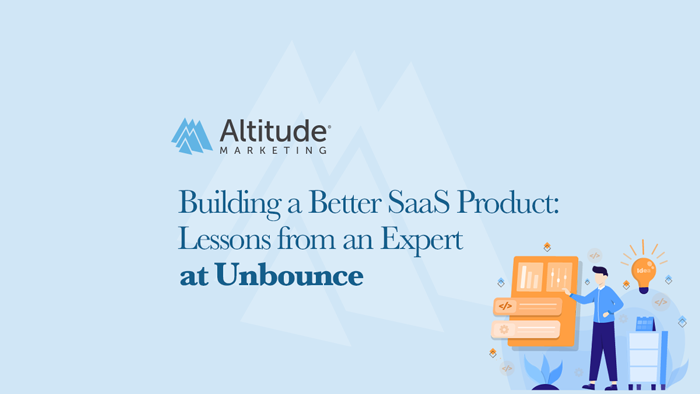There’s nothing more important to a marketer than the product they’re selling. If it fails to perform well or meet a clear market demand, the best campaign in the world isn’t going to help.
On the other hand, a killer product has the potential to grow like gangbusters. Demand gen and lead gen are never “easy” – nothing sells itself. But a great SaaS solution sure makes life easier for folks like us.
Of course, getting to that point isn’t an overnight process. It takes time, effort and strategy. But it is possible.
How can your dev team get from here to there? We sat down with Chris Brownlee, the Senior Director of Product Management at Unbounce, to find out.
Chris gave us some great insights into how Unbounce thinks up, creates and deploys pieces of its platform.

But First: What’s Unbounce?
If you’re a B2B marketer, you need landing pages, popups and other conversion points to help move prospects through your marketing funnel. These are the places where prospects turn into leads and sales.
Unbounce is the leading landing page software that makes it easy to build those. Like, really easy. No CMS, no code (unless you want to get fancy). It’s pretty great. Suffice to say, there’s a reason it’s broadly considered the world’s #1 platform of its type.
The company started in Vancouver in 2009. It’s since grown to about 200 employees, and just took its first sizable funding round ($38.4 million U.S.).
So yeah, Unbounce is doing well.
And it all comes down to the product.
Well, Actually …
Unbounce is thriving because they truly understand their product and market. And that’s not always an easy thing to do.
Ask your average Unbounce user what the software is, and they’ll probably tell you it’s a landing page builder.
True. But not 100% true.
That leads us to Brownlee’s first tip for building a better SaaS product: know your purpose.
Tip #1: Understand Your Why
Yes, Unbounce is a landing page builder ( plus popups and sticky bars, too.) But that’s a what. Those aren’t why’s.
Why does Unbounce exist? It’s a platform for helping marketers get more conversions.
Many Unbounce customers are SMBs. For them, it’s critical to maximize ROI on their ad spends. Every form completion or goal drives up ROAS, and makes it possible to play with the big boys.
So what’s on the mind of Brownlee and his team, all day every day?
Conversions.
So Unbounce didn’t pigeon-hole itself into just “making it easier to build landing pages.” They created features and functionality that maximize conversions. That’s why marketers choose Unbounce over other software options – because maximizing conversions is the name of the game.
(Heck, it’s even what their new pricing model is based on.)
So don’t forget your why. It’s what keeps you focused.
Of course, understanding any business’ “why” is a task unto itself. Here are some tips for how to figure it out.
Tip #2: Talk to Your Users
You know who can tell you what your customers need?
Your customers.
Sounds obvious, right? But a lot of companies forget to tap this insanely valuable resource.
Not Unbounce, however.
The majority of their feature and enhancement ideas come from interviews with users of their tool. They come from demos. They come from customers who reach for support. They come from the Unbounce Community forum. They even come from customers who churn to a competitor.
Always remember: You’re building something for someone else. It’s not about what you think is cool. It’s about what they want and need.
Ask them, and act on their feedback.
Here’s an example.
Unbounce users needed more conversions. But to do so, they’d need to optimize their traffic and traditional A/B testing requires a ton of users to reach a decent confidence level.
Many Unbounce users couldn’t get enough traffic to their landing page to make their testing worthwhile. Problem is, you can’t optimize for conversions without testing.
How do you square that circle?
Unbounce listened. They took the time to understand their customers’ issues and then they built something really cool (and valuable) based on their why.
The result? Smart Traffic, an AI-powered automation platform capable of automatically optimizing for conversions based on as few as 50 visitors.

Customers got a solution, and Unbounce offered up a killer new feature.
Naturally, it’s not always that easy to build a product feature. Which leads us to the last point Brownlee brought up.
Tip #3: Fail Sometimes
The only way to optimize for conversions is to experiment and test. Building a better SaaS product is no different.
Embrace ideas. Try new things. Build prototypes and put them in your users’ hands.
Some will fly. Some will flop. And that’s fine! Celebrate your failures. They’re learning opportunities, and knowing what doesn’t work is just as important as knowing what does.
Be prepared for four out of five of your great ideas to end up on the cutting room floor. But the one that hits might be a game-changer. Patience is a virtue.
tl;dr: Build a Better SaaS Product
Great products don’t just happen.
They’re built with a greater purpose and a true marketplace need in mind.
They’re the result of hours of research and countless conversations.
And they’re constantly being improved.
Are you going to start building products like Unbounce tomorrow? Probably not.
But if you know your why, talk to your customers and bake experimentation into your DNA, you can make great things happen–one step at a time.
Want to try Unbounce? You should. And we want to make it easy on you. Use this link to get two weeks free and 20% off your subscription.



